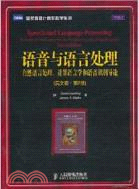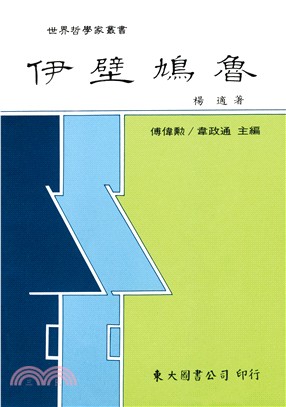語音與語言處理:自然語言處理、計算語言學和語音識別導論(英文版)(第2版)(簡體書)
商品資訊
人民幣定價:138 元
定價
:NT$ 828 元優惠價
:87 折 720 元
絕版無法訂購
相關商品
商品簡介
作者簡介
目次
商品簡介
本書全面系統地介紹了計算機自然語言處理。全書分為5個部分,共21章,深入細致地探討了計算機處理自然語言的詞匯、語法、語義、語用等各個方面的問題,介紹了自然語言處理的各種現代技術。在本書的配套網站上,還提供了相關的資源和工具,便于讀者在實踐中進一步提高。 本書不僅可以作為高等學校自然語言處理和計算語言學等課程的本科生和研究生教材,而且也是自然語言處理相關領域的研究人員和技術人員的必備參考。
作者簡介
(美國)Daniel Jurafsky^James H.Martin
目次
Contents 1 Introduction 35 1.1 Knowledge in Speech and Language Processing 36 1.2 Ambiguity 38 1.3 Models andAlgorithms 39 1.4 Language, Thought, and Understanding 40 1.5 TheState of theArt 42 1.6 SomeBriefHistory 43 1.6.1 Foundational Insights: 1940s and 1950s 43 1.6.2 The Two Camps: 1957—1970 44 1.6.3 Four Paradigms: 1970—1983 45 1.6.4 Empiricism and Finite-State Models Redux: 1983—1993 46 1.6.5 The Field Comes Together: 1994—1999 46 1.6.6 The Rise of Machine Learning: 2000—2008 46 1.6.7 On Multiple Discoveries 47 1.6.8 A Final Brief Note on Psychology 48 1.7 Summary 48 Bibliographical and Historical Notes 49 I Words 2 Regular Expressions and Automata 51 2.1 RegularExpressions 51 2.1.1 Basic Regular Expression Patterns 52 2.1.2 Disjunction, Grouping, and Precedence 55 2.1.3 ASimpleExample 56 2.1.4 A More Complex Example 57 2.1.5 AdvancedOperators 58 2.1.6 Regular Expression Substitution, Memory, and ELIZA 59 2.2 Finite-StateAutomata 60 2.2.1 Use of an FSA to Recognize Sheeptalk 61 2.2.2 Formal Languages 64 2.2.3 Another Example 65 2.2.4 Non-Deterministic FSAs 66 2.2.5 Use of an NFSA to Accept Strings 67 2.2.6 Recognition as Search 69 2.2.7 Relation of Deterministic and Non-Deterministic Automata 72 2.3 Regular Languages and FSAs 72 2.4 Summary 75 Bibliographical and Historical Notes 76 Exercises 76 3 Words and Transducers 79 3.1 Survey of (Mostly) English Morphology 81 3.1.1 Inflectional Morphology 82 3.1.2 Derivational Morphology 84 3.1.3 Cliticization 85 3.1.4 Non-Concatenative Morphology 85 3.1.5 Agreement 86 3.2 Finite-State Morphological Parsing 86 3.3 Construction of a Finite-State Lexicon 88 3.4 Finite-StateTransducers 91 3.4.1 Sequential Transducers and Determinism 93 3.5 FSTs for Morphological Parsing 94 3.6 Transducers and Orthographic Rules 96 3.7 The Combination of an FST Lexicon and Rules 99 3.8 Lexicon-Free FSTs: The Porter Stemmer 102 3.9 Word and Sentence Tokenization 102 3.9.1 Segmentation in Chinese 104 3.10 Detection and Correction of Spelling Errors 106 3.11 MinimumEditDistance 107 3.12 Human Morphological Processing 111 3.13 Summary 113 Bibliographical and Historical Notes 114 Exercises 115 4 N-Grams 117 4.1 WordCounting inCorpora 119 4.2 Simple (Unsmoothed) N-Grams 120 4.3 Training andTestSets 125 4.3.1 N-Gram Sensitivity to the Training Corpus 126 4.3.2 Unknown Words: Open Versus Closed Vocabulary Tasks 129 4.4 Evaluating N-Grams: Perplexity 129 4.5 Smoothing 131 4.5.1 LaplaceSmoothing 132 4.5.2 Good-Turing Discounting 135 4.5.3 Some Advanced Issues in Good-Turing Estimation 136 4.6 Interpolation 138 4.7 Backoff 139 4.7.1 Advanced: Details of Computing Katz Backoff α and P* 141 4.8 Practical Issues: Toolkits and Data Formats 142 4.9 Advanced Issues in Language Modeling 143 4.9.1 Advanced Smoothing Methods: Kneser-Ney Smoothing 143 4.9.2 Class-Based N-Grams 145 4.9.3 Language Model Adaptation and Web Use 146 4.9.4 Using Longer-Distance Information: A Brief Summary 146 4.10 Advanced: Information Theory Background 148 4.10.1 Cross-Entropy for Comparing Models 150 4.11 Advanced: The Entropy of English and Entropy Rate Constancy 152 4.12 Summary 153 Bibliographical and Historical Notes 154 Exercises 155 5 Part-of-Speech Tagging 157 5.1 (Mostly) English Word Classes 158 5.2 Tagsets forEnglish 164 5.3 Part-of-Speech Tagging 167 5.4 Rule-Based Part-of-Speech Tagging 169 5.5 HMM Part-of-Speech Tagging 173 5.5.1 Computing the Most Likely Tag Sequence: An Example 176 5.5.2 Formalizing Hidden Markov Model Taggers 178 5.5.3 Using the Viterbi Algorithm for HMM Tagging 179 5.5.4 Extending the HMM Algorithm to Trigrams 183 5.6 Transformation-Based Tagging 185 5.6.1 How TBL Rules Are Applied 186 5.6.2 How TBL Rules Are Learned 186 5.7 Evaluation and Error Analysis 187 5.7.1 ErrorAnalysis 190 5.8 Advanced Issues in Part-of-Speech Tagging 191 5.8.1 Practical Issues: Tag Indeterminacy and Tokenization 191 5.8.2 Unknown Words 192 5.8.3 Part-of-Speech Tagging for Other Languages 194 5.8.4 Tagger Combination 197 5.9 Advanced: The Noisy Channel Model for Spelling 197 5.9.1 Contextual Spelling Error Correction 201 5.10 Summary 202 Bibliographical and Historical Notes 203 Exercises 205 6 Hidden Markov and Maximum Entropy Models 207 6.1 Markov Chains 208 6.2 The Hidden Markov Model 210 6.3 Likelihood Computation: The Forward Algorithm 213 6.4 Decoding: The Viterbi Algorithm 218 6.5 HMM Training: The Forward-Backward Algorithm 220 6.6 Maximum Entropy Models: Background 227 6.6.1 Linear Regression 228 6.6.2 Logistic Regression 231 6.6.3 Logistic Regression: Classification 233 6.6.4 Advanced: Learning in Logistic Regression 234 6.7 Maximum Entropy Modeling 235 6.7.1 Why We Call It Maximum Entropy 239 6.8 Maximum Entropy Markov Models 241 6.8.1 Decoding and Learning in MEMMs 244 6.9 Summary 245 Bibliographical and Historical Notes 246 Exercises 247 II Speech 7 Phonetics 249 7.1 Speech Sounds and Phonetic Transcription 250 7.2 Articulatory Phonetics 251 7.2.1 The Vocal Organs 252 7.2.2 Consonants: Place of Articulation 254 7.2.3 Consonants: Manner of Articulation 255 7.2.4 Vowels 256 7.2.5 Syllables 257 7.3 Phonological Categories and Pronunciation Variation 259 7.3.1 Phonetic Features 261 7.3.2 Predicting Phonetic Variation 262 7.3.3 Factors Influencing Phonetic Variation 263 7.4 Acoustic Phonetics and Signals 264 7.4.1 Waves 264 7.4.2 Speech Sound Waves 265 7.4.3 Frequency and Amplitude; Pitch and Loudness 267 7.4.4 Interpretation of Phones from a Waveform 270 7.4.5 Spectra and the Frequency Domain 270 7.4.6 The Source-Filter Model 274 7.5 Phonetic Resources 275 7.6 Advanced: Articulatory and Gestural Phonology 278 7.7 Summary 279 Bibliographical and Historical Notes 280 Exercises 281 8 Speech Synthesis 283 8.1 Text Normalization 285 8.1.1 Sentence Tokenization 285 8.1.2 Non-Standard Words 286 8.1.3 Homograph Disambiguation 290 8.2 Phonetic Analysis 291 8.2.1 Dictionary Lookup 291 8.2.2 Names 292 8.2.3 Grapheme-to-Phoneme Conversion 293 8.3 Prosodic Analysis 296 8.3.1 Prosodic Structure 296 8.3.2 Prosodic Prominence 297 8.3.3 Tune 299 8.3.4 More Sophisticated Models: ToBI 300 8.3.5 Computing Duration from Prosodic Labels 302 8.3.6 Computing F0 from Prosodic Labels 303 8.3.7 Final Result of Text Analysis: Internal Representation 305 8.4 Diphone Waveform Synthesis 306 8.4.1 Steps for Building a Diphone Database 306 8.4.2 Diphone Concatenation and TD-PSOLA for Prosody 308 8.5 Unit Selection (Waveform) Synthesis 310 8.6 Evaluation 314 Bibliographical and Historical Notes 315 Exercises 318 9 Automatic Speech Recognition 319 9.1 Speech Recognition Architecture 321 9.2 The Hidden Markov Model Applied to Speech 325 9.3 Feature Extraction: MFCC Vectors 329 9.3.1 Preemphasis 330 9.3.2 Windowing 330 9.3.3 Discrete Fourier Transform 332 9.3.4 Mel Filter Bank and Log 333 9.3.5 The Cepstrum: Inverse Discrete Fourier Transform 334 9.3.6 Deltas and Energy 336 9.3.7 Summary:MFCC 336 9.4 Acoustic Likelihood Computation 337 9.4.1 Vector Quantization 337 9.4.2 Gaussian PDFs 340 9.4.3 Probabilities, Log-Probabilities, and Distance Functions 347 9.5 The Lexicon and Language Model 348 9.6 Search and Decoding 348 9.7 Embedded Training 358 9.8 Evaluation: Word Error Rate 362 9.9 Summary 364 Bibliographical and Historical Notes 365 Exercises 367 10 Speech Recognition: Advanced Topics 369 10.1 Multipass Decoding: N-Best Lists and Lattices 369 10.2 A*(“Stack”)Decoding 375 10.3 Context-Dependent Acoustic Models: Triphones 379 10.4 Discriminative Training 383 10.4.1 Maximum Mutual Information Estimation 384 10.4.2 Acoustic Models Based on Posterior Classifiers 385 10.5 Modeling Variation 386 10.5.1 Environmental Variation and Noise 386 10.5.2 Speaker Variation and Speaker Adaptation 387 10.5.3 Pronunciation Modeling: Variation Due to Genre 388 10.6 Metadata: Boundaries, Punctuation, and Disfluencies 390 10.7 Speech Recognition by Humans 392 10.8 Summary 393 Bibliographical and Historical Notes 393 Exercises 394 11 Computational Phonology 395 11.1 Finite-State Phonology 395 11.2 Advanced Finite-State Phonology 399 11.2.1 Harmony 399 11.2.2 Templatic Morphology 400 11.3 Computational Optimality Theory 401 11.3.1 Finite-State Transducer Models of Optimality Theory 403 11.3.2 Stochastic Models of Optimality Theory 404 11.4 Syllabification 406 11.5 Learning Phonology and Morphology 409 11.5.1 Learning Phonological Rules 409 11.5.2 Learning Morphology 411 11.5.3 Learning in Optimality Theory 414 11.6 Summary 415 Bibliographical and Historical Notes 415 Exercises 417 III Syntax 12 Formal Grammars of English 419 12.1 Constituency 420 12.2 Context-FreeGrammars 421 12.2.1 Formal Definition of Context-Free Grammar 425 12.3 Some Grammar Rules for English 426 12.3.1 Sentence-Level Constructions 426 12.3.2 Clauses and Sentences 428 12.3.3 The Noun Phrase 428 12.3.4 Agreement 432 12.3.5 The Verb Phrase and Subcategorization 434 12.3.6 Auxiliaries 436 12.3.7 Coordination 437 12.4 Treebanks 438 12.4.1 Example: The Penn Treebank Project 438 12.4.2 Treebanks as Grammars 440 12.4.3 Treebank Searching 442 12.4.4 Heads and Head Finding 443 12.5 Grammar Equivalence and Normal Form 446 12.6 Finite-State and Context-Free Grammars 447 12.7 Dependency Grammars 448 12.7.1 The Relationship Between Dependencies and Heads 449 12.7.2 Categorial Grammar 451 12.8 Spoken Language Syntax 451 12.8.1 Disfluencies andRepair 452 12.8.2 Treebanks for Spoken Language 453 12.9 Grammars and Human Processing 454 12.10 Summary 455 Bibliographical and Historical Notes 456 Exercises 458 13 Syntactic Parsing 461 13.1 Parsing as Search 462 13.1.1 Top-Down Parsing 463 13.1.2 Bottom-Up Parsing 464 13.1.3 Comparing Top-Down and Bottom-Up Parsing 465 13.2 Ambiguity 466 13.3 Search in the Face of Ambiguity 468 13.4 Dynamic Programming Parsing Methods 469 13.4.1 CKY Parsing 470 13.4.2 The Earley Algorithm 477 13.4.3 Chart Parsing 482 13.5 Partial Parsing 484 13.5.1 Finite-State Rule-Based Chunking 486 13.5.2 Machine Learning-Based Approaches to Chunking 486 13.5.3 Chunking-System Evaluations 489 13.6 Summary 490 Bibliographical and Historical Notes 491 Exercises 492 14 Statistical Parsing 493 14.1 Probabilistic Context-Free Grammars 494 14.1.1 PCFGs for Disambiguation 495 14.1.2 PCFGs for Language Modeling 497 14.2 Probabilistic CKY Parsing of PCFGs 498 14.3 Ways to Learn PCFG Rule Probabilities 501 14.4 Problemswith PCFGs 502 14.4.1 Independence Assumptions Miss Structural Dependencies Between Rules 502 14.4.2 Lack of Sensitivity to Lexical Dependencies 503 14.5 Improving PCFGs by Splitting Non-Terminals 505 14.6 Probabilistic Lexicalized CFGs 507 14.6.1 The Collins Parser 509 14.6.2 Advanced: Further Details of the Collins Parser 511 14.7 EvaluatingParsers 513 14.8 Advanced: Discriminative Reranking 515 14.9 Advanced: Parser-Based Language Modeling 516 14.10 Human Parsing 517 14.11 Summary 519 Bibliographical and Historical Notes 520 Exercises 522 15 Features and Unification 523 15.1 Feature Structures 524 15.2 Unification of Feature Structures 526 15.3 Feature Structures in the Grammar 531 15.3.1 Agreement 532 15.3.2 Head Features 534 15.3.3 Subcategorization 535 15.3.4 Long-Distance Dependencies 540 15.4 Implementation of Unification 541 15.4.1 Unification Data Structures 541 15.4.2 The Unification Algorithm 543 15.5 Parsing with Unification Constraints 547 15.5.1 Integration of Unification into an Earley Parser 548 15.5.2 Unification-Based Parsing 553 15.6 Types and Inheritance 555 15.6.1 Advanced: Extensions to Typing 558 15.6.2 Other Extensions to Unification 559 15.7 Summary 559 Bibliographical and Historical Notes 560 Exercises 561 16 Language and Complexity 563 16.1 The Chomsky Hierarchy 564 16.2 Ways to Tell if a Language Isnt Regular 566 16.2.1 The Pumping Lemma 567 16.2.2 Proofs that Various Natural Languages Are Not Regular 569 16.3 Is Natural Language Context Free? 571 16.4 Complexity and Human Processing 573 16.5 Summary 576 Bibliographical and Historical Notes 577 Exercises 578 17 The Representation of Meaning 579 17.1 Computational Desiderata for Representations 581 17.1.1 Verifiability 581 17.1.2 Unambiguous Representations 582 17.1.3 Canonical Form 583 17.1.4 Inference and Variables 584 17.1.5 Expressiveness 585 17.2 Model-Theoretic Semantics 586 17.3 First-OrderLogic 589 17.3.1 Basic Elements of First-Order Logic 589 17.3.2 Variables and Quantifiers 591 17.3.3 LambdaNotation 593 17.3.4 The Semantics of First-Order Logic 594 17.3.5 Inference 595 17.4 Event and State Representations 597 17.4.1 Representing Time 600 17.4.2 Aspect 603 17.5 Description Logics 606 17.6 Embodied and Situated Approaches to Meaning 612 17.7 Summary 614 Bibliographical and Historical Notes 614 Exercises 616 18 Computational Semantics 617 18.1 Syntax-Driven Semantic Analysis 617 18.2 Semantic Augmentations to Syntactic Rules 619 18.3 Quantifier Scope Ambiguity and Underspecification 626 18.3.1 Store and Retrieve Approaches 626 18.3.2 Constraint-Based Approaches 629 18.4 Unification-Based Approaches to Semantic Analysis 632 18.5 Integration of Semantics into the Earley Parser 638 18.6 Idioms and Compositionality 639 18.7 Summary 641 Bibliographical and Historical Notes 641 Exercises 643 19 Lexical Semantics 645 19.1 Word Senses 646 19.2 Relations Between Senses 649 19.2.1 Synonymy and Antonymy 649 19.2.2 Hyponymy 650 19.2.3 Semantic Fields 651 19.3 WordNet: A Database of Lexical Relations 651 19.4 Event Participants 653 19.4.1 Thematic Roles 654 19.4.2 Diathesis Alternations 656 19.4.3 Problems with Thematic Roles 657 19.4.4 The Proposition Bank 658 19.4.5 FrameNet 659 19.4.6 Selectional Restrictions 661 19.5 Primitive Decomposition 663 19.6 Advanced: Metaphor 665 19.7 Summary 666 Bibliographical and Historical Notes 667 Exercises 668 20 Computational Lexical Semantics 671 20.1 Word Sense Disambiguation: Overview 672 20.2 Supervised Word Sense Disambiguation 673 20.2.1 Feature Extraction for Supervised Learning 674 20.2.2 Naive Bayes and Decision List Classifiers 675 20.3 WSD Evaluation, Baselines, and Ceilings 678 20.4 WSD: Dictionary and Thesaurus Methods 680 20.4.1 The Lesk Algorithm 680 20.4.2 Selectional Restrictions and Selectional Preferences 682 20.5 Minimally Supervised WSD: Bootstrapping 684 20.6 Word Similarity: Thesaurus Methods 686 20.7 Word Similarity: Distributional Methods 692 20.7.1 Defining a Words Co-Occurrence Vectors 693 20.7.2 Measuring Association with Context 695 20.7.3 Defining Similarity Between Two Vectors 697 20.7.4 Evaluating Distributional Word Similarity 701 20.8 Hyponymy and Other Word Relations 701 20.9 Semantic RoleLabeling 704 20.10 Advanced: Unsupervised Sense Disambiguation 708 20.11 Summary 709 Bibliographical and Historical Notes 710 Exercises 713 21 Computational Discourse 715 21.1 Discourse Segmentation 718 21.1.1 Unsupervised Discourse Segmentation 718 21.1.2 Supervised Discourse Segmentation 720 21.1.3 Discourse Segmentation Evaluation 722 21.2 Text Coherence 723 21.2.1 Rhetorical Structure Theory 724 21.2.2 Automatic Coherence Assignment 726 21.3 Reference Resolution 729 21.4 Reference Phenomena 732 21.4.1 Five Types of Referring Expressions 732 21.4.2 Information Status 734 21.5 Features for Pronominal Anaphora Resolution 735 21.5.1 Features for Filtering Potential Referents 735 21.5.2 Preferences in Pronoun Interpretation 736 21.6 Three Algorithms for Anaphora Resolution 738 21.6.1 Pronominal Anaphora Baseline: The Hobbs Algorithm 738 21.6.2 A Centering Algorithm for Anaphora Resolution 740 21.6.3 A Log-Linear Model for Pronominal Anaphora Resolution 742 21.6.4 Features for Pronominal Anaphora Resolution 743 21.7 Coreference Resolution 744 21.8 Evaluation of Coreference Resolution 746 21.9 Advanced: Inference-Based Coherence Resolution 747 21.10 Psycholinguistic Studies of Reference 752 21.11 Summary 753 Bibliographical and Historical Notes 754 Exercises 756 V Applications 22 Information Extraction 759 22.1 Named Entity Recognition 761 22.1.1 Ambiguity in Named Entity Recognition 763 22.1.2 NER as Sequence Labeling 763 22.1.3 Evaluation of Named Entity Recognition 766 22.1.4 Practical NER Architectures 768 22.2 Relation Detection and Classi?cation 768 22.2.1 Supervised Learning Approaches to Relation Analysis 769 22.2.2 Lightly Supervised Approaches to Relation Analysis 772 22.2.3 Evaluation of Relation Analysis Systems 776 22.3 Temporal and Event Processing 777 22.3.1 Temporal Expression Recognition 777 22.3.2 Temporal Normalization 780 22.3.3 Event Detection and Analysis 783 22.3.4 TimeBank 784 22.4 Template Filling 786 22.4.1 Statistical Approaches to Template-Filling 786 22.4.2 Finite-State Template-Filling Systems 788 22.5 Advanced: Biomedical Information Extraction 791 22.5.1 Biological Named Entity Recognition 792 22.5.2 Gene Normalization 793 22.5.3 Biological Roles and Relations 794 22.6 Summary 796 Bibliographical and Historical Notes 796 Exercises 797 23 Question Answering and Summarization 799 23.1 Information Retrieval 801 23.1.1 The Vector Space Model 802 23.1.2 TermWeighting 804 23.1.3 Term Selection and Creation 806 23.1.4 Evaluation of Information-Retrieval Systems 806 23.1.5 Homonymy, Polysemy, and Synonymy 810 23.1.6 Ways to Improve User Queries 810 23.2 Factoid Question Answering 812 23.2.1 Question Processing 813 23.2.2 Passage Retrieval 815 23.2.3 Answer Processing 817 23.2.4 Evaluation of Factoid Answers 821 23.3 Summarization 821 23.4 Single-Document Summarization 824 23.4.1 Unsupervised Content Selection 824 23.4.2 Unsupervised Summarization Based on Rhetorical Parsing 826 23.4.3 Supervised Content Selection 828 23.4.4 Sentence Simplification 829 23.5 Multi-Document Summarization 830 23.5.1 Content Selection in Multi-Document Summarization 831 23.5.2 Information Ordering in Multi-Document Summarization 832 23.6 Focused Summarization and Question Answering 835 23.7 Summarization Evaluation 839 23.8 Summary 841 Bibliographical and Historical Notes 842 Exercises 844 24 Dialogue and Conversational Agents 847 24.1 Properties of Human Conversations 849 24.1.1 Turns and Turn-Taking 849 24.1.2 Language as Action: Speech Acts 851 24.1.3 Language as Joint Action: Grounding 852 24.1.4 Conversational Structure 854 24.1.5 Conversational Implicature 855 24.2 Basic Dialogue Systems 857 24.2.1 ASR Component 857 24.2.2 NLU Component 858 24.2.3 Generation and TTS Components 861 24.2.4 Dialogue Manager 863 24.2.5 Dealing with Errors: Confirmation and Rejection 867 24.3 VoiceXML 868 24.4 Dialogue System Design and Evaluation 872 24.4.1 Designing Dialogue Systems 872 24.4.2 Evaluating Dialogue Systems 872 24.5 Information-State and Dialogue Acts 874 24.5.1 Using Dialogue Acts 876 24.5.2 Interpreting Dialogue Acts 877 24.5.3 Detecting Correction Acts 880 24.5.4 Generating Dialogue Acts: Confirmation and Rejection 881 24.6 Markov Decision Process Architecture 882 24.7 Advanced: Plan-Based Dialogue Agents 886 24.7.1 Plan-Inferential Interpretation and Production 887 24.7.2 The Intentional Structure of Dialogue 889 24.8 Summary 891 Bibliographical and Historical Notes 892 Exercises 894 25 Machine Translation 895 25.1 Why Machine Translation Is Hard 898 25.1.1 Typology 898 25.1.2 Other Structural Divergences 900 25.1.3 Lexical Divergences 901 25.2 Classical MT and the Vauquois Triangle 903 25.2.1 Direct Translation 904 25.2.2 Transfer 906 25.2.3 Combined Direct and Transfer Approaches in Classic MT 908 25.2.4 The Interlingua Idea: Using Meaning 909 25.3 Statistical MT 910 25.4 P(F|E): The Phrase-Based Translation Model 913 25.5 Alignment in MT 915 25.5.1 IBM Model 1 916 25.5.2 HMM Alignment 919 25.6 Training Alignment Models 921 25.6.1 EM for Training Alignment Models 922 25.7 Symmetrizing Alignments for Phrase-Based MT 924 25.8 Decoding for Phrase-Based Statistical MT 926 25.9 MTEvaluation 930 25.9.1 Using Human Raters 930 25.9.2 Automatic Evaluation: BLEU 931 25.10 Advanced: Syntactic Models for MT 934 25.11 Advanced: IBM Model 3 and Fertility 935 25.11.1 Training forModel 3 939 25.12 Advanced: Log-Linear Models for MT 939 25.13 Summary 940 Bibliographical and Historical Notes 941 Exercises 943 Bibliography 945 Author Index 995 Subject Index 1007
主題書展
更多
主題書展
更多書展本週66折
您曾經瀏覽過的商品
購物須知
大陸出版品因裝訂品質及貨運條件與台灣出版品落差甚大,除封面破損、內頁脫落等較嚴重的狀態,其餘商品將正常出貨。
特別提醒:部分書籍附贈之內容(如音頻mp3或影片dvd等)已無實體光碟提供,需以QR CODE 連結至當地網站註冊“並通過驗證程序”,方可下載使用。
無現貨庫存之簡體書,將向海外調貨:
海外有庫存之書籍,等候約45個工作天;
海外無庫存之書籍,平均作業時間約60個工作天,然不保證確定可調到貨,尚請見諒。
為了保護您的權益,「三民網路書店」提供會員七日商品鑑賞期(收到商品為起始日)。
若要辦理退貨,請在商品鑑賞期內寄回,且商品必須是全新狀態與完整包裝(商品、附件、發票、隨貨贈品等)否則恕不接受退貨。

























